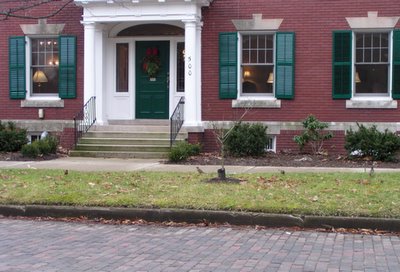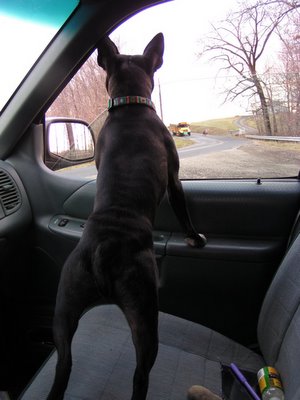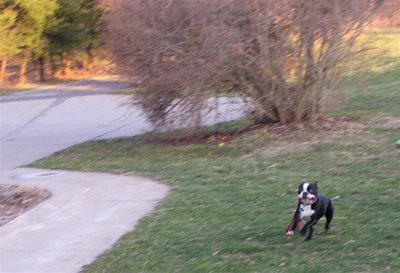
O wonderful surprise: a flock of robins, pulling inch after inch of earthworms from the soggy strip between one of Marietta College's administration buildings and Putnam Street. I pulled over and shot a few pictures. No, they're not the first robins of spring; they're nomadic, winter robins, wandering around eating hawthorns and, when drenching rains thaw the soil, availing themselves of earthworms. Robins make me so happy. We're so lucky to have this big, strong, beautiful thrush as a common city bird. It doesn't have to be so lovely, but it is...and its song is one of my very favorites. George Sutton's favorite bird song was a robin, after a thunderstorm. I can think of very few bird songs as evocative as that of a damp robin.
I spent the day in town, ricocheting around, procuring food, and meeting Bill for a late lunch at the natural foods shop and cafe in town. I'm almost as thankful for Brighter Day as I am for robins; it would be so easy for a small town like Marietta not to have a hippie food store. But there it is, and I love the food they serve and the arcane edibles we can buy there (I'm on a spirulina shake kick lately). There's something about eating soybeans and algae for two meals a day that feels right to me. Yep, algae. Now that's eating low on the food chain.
Got home just in time to put everything away, collect Chet, and go meet the bus. If I drive eight minutes to meet them partway, I can save the kids 30 minutes on the bus. With the finely-tuned consciousness of dogs, Chet knows the very minute we must leave to pick them up, and he comes to get me, eyes dancing with anticipation. He trembles when he spots the bus, every muscle rigid, and he moans softly when he spots the kids emerging. He washes their faces and by his careful inspection of their skin and clothes, I'm sure he can smell their friends on them, what they had for lunch, the disinfectant in the hall, and what was being served in the cafeteria. Oh, to be a dog just for a day, so I could know all that, too.
 With the kids home, it was finally time for the Loop. I take his leash as a formality, just in case we run across cattle. He loves to grab his leash and romp with it. He wears it for about 30 seconds as we approach the overlook where there might be cattle, and then I free him again. He covers enormous distances chasing squirrels, deer and sometimes turkeys. If I ran the miles he did on every walk, I wouldn't have to be eating algae for breakfast and lunch.
With the kids home, it was finally time for the Loop. I take his leash as a formality, just in case we run across cattle. He loves to grab his leash and romp with it. He wears it for about 30 seconds as we approach the overlook where there might be cattle, and then I free him again. He covers enormous distances chasing squirrels, deer and sometimes turkeys. If I ran the miles he did on every walk, I wouldn't have to be eating algae for breakfast and lunch. 
My motto for 2006 is DO MORE, EAT LESS. I've been living it since the day we got home from our Thanksgiving trip to Maryland. I felt, in my friend Cindy the Forester's words, "like a one pound package of Jimmy Dean Sausage. The only difference is that I am clad in denim and fleece instead of plastic and not wound quite so tight on the ends!" Oh, thank you, Cindy, for that image, a sausage walking through the woods...for the record, she's perfectly proportioned...It's amazing how little food we actually need. My dad liked to say that a handful of parched corn could keep a Civil War soldier marching all day. At least that's what he would say as he was stealthily trying to commandeer the stove so he could parch corn. Parched corn is a crispier version of the old maids from the bottom of the popcorn pan, but I loved it. As I think back on it, I was very faithful to my dad and his antique and bizarre notions, and he enlisted me to shield himself from the dubious looks he got from my mom when he tried to do anything in the kitchen. He grew soybeans to eat long before soybeans were cool. He got me to shell them (what a pain) and I remember proclaiming to the rest of the family that I thought they were delicious.
So I've come full circle, back to the humble soybean. I heard an item on Morning Edition today that farmers from the American Midwest are buying up enormous tracts (think 8,000 acres and up) of the "scrubland" of northeastern Brazil, and planting them to soybeans. The story was upbeat about enormous yields and cheap land, running about $275/acre; "ideal for agriculture." (The six-month dry season notwithstanding, apparently). The obvious questions were never raised. It left me wondering just how long that land would be ideal for soybeans before we simply ruin it. There's got to be a reason it's "scrubland," not lush tallgrass prairie like our Great Plains breadbasket once had. I guess this is a story whose epilogue has yet to be written. But it made me sad, all the same, knowing that there are habitats in that so-called wasteland, birds and animals and insects and plants unique to them, and that they are being burned away, and turned under for quick profit. We make the same mistakes over and over and over, but we have to go farther afield to make them now.






0 comments:
Post a Comment